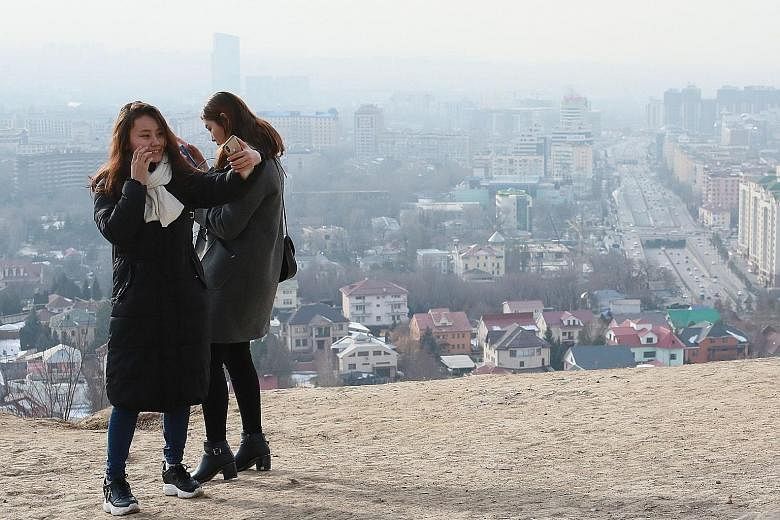BISHKEK (KYRGYZSTAN) • Snow-capped peaks used to be clearly visible from the streets of Almaty and Bishkek, two of the largest cities in Central Asia that both lie in plains surrounded by mountains.
But now, a heavy cloud of dark smog often blots out the view as air pollution regularly soars to levels comparable to those in New Delhi and Lahore, even though Almaty and Bishkek have fewer people and industries than their Indian and Pakistani counterparts.
In the Kyrgyz capital of Bishkek, a city of one million, and Kazakhstan's second city of Almaty, which is twice as large, the onset of winter prompts a surge in pollution as people burn coal and other dirty fuels in stoves to heat their homes.
Kyrgyz environmental activist Kunduz Adylbekova experiences the problem first-hand. In the area where she lives on the outskirts of Bishkek, the air quality is particularly bad. "The air here has a kind of heavy feel," said Ms Adylbekova, a programme manager.
Many locals use highly polluting stoves to heat their homes and boil water because they are not hooked up to mains gas. Large numbers of ageing cars and trucks exacerbate the situation.
In this district, readings of PM 2.5 - a measure of fine particles in the air - regularly reach levels that the United States Environmental Protection Agency (EPA) defines as hazardous to human health.
Sometimes, readings are four times higher than the EPA "hazardous" level, Ms Adylbekova said. "Residents are often ill, some suffer from lung problems."
The bowl-shaped topography of both cities helps trap pollution.
Even worse, both have coal-fired power stations that date back to the Soviet era. But other factors have led to a massive increase in the smog problem over the past two decades. In Almaty, many cite the huge growth in the number of cars since the break-up of the Soviet Union.
Mr Zhalgas Jakiyanov, a marketing specialist who works in the business district, said the growing pollution is "already having an effect on our health". "We need to switch to gas heating instead of using solid fuels. There needs to be more emphasis on spaces for pedestrians."
Smog also afflicts the capitals of former Soviet republics to the south, Uzbekistan and Tajikistan.
But governments have been slower to acknowledge the problem. This month, an online petition demanding that Almaty's authorities declare the poor air quality as an emergency gained 17,000 signatures on the first day. The city administration responded by saying that it was looking into ways to modernise the main coal-burning power station.
But it said no decision on the upgrade will be made until the end of the year and ignored calls for an independent assessment of the plant.
In Kyrgyzstan, the authorities rely on Russian energy giant Gazprom to expand its gas pipeline network into new areas of the capital in order to wean house owners off domestic stoves.
But Ms Adylbekova said her family had to pay around US$500 (S$695) to hook up to the network last November. That is too much for many residents, she said.
The city carries out regular raids on residents suspected of burning banned fuels. One woman was fined about US$107 - over half the average monthly salary - for burning leftover fabric from the garment industry.
"We have asked the government about (installing) mains gas and plumbing," said housewife Baktygul Beishereva, who wore a surgical mask. "But no one is looking out for us here."
AGENCE FRANCE-PRESSE

